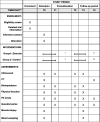Blood flow restriction Exercise in the perioperative setting to Prevent loss of muscle mass in patients with pancreatic, biliary tract, and liver cancer: study protocol for the PREV-Ex randomized controlled trial
- PMID: 38835083
- PMCID: PMC11149261
- DOI: 10.1186/s13063-024-08207-5
Blood flow restriction Exercise in the perioperative setting to Prevent loss of muscle mass in patients with pancreatic, biliary tract, and liver cancer: study protocol for the PREV-Ex randomized controlled trial
Abstract
Background: Patients diagnosed with pancreatic, biliary tract, and liver cancer often suffer from a progressive loss of muscle mass. Given the considerable functional impairments in these patients, high musculoskeletal weight loads may not be well tolerated by all individuals. The use of blood-flow restricted resistance training (BFR-T) which only requires low training loads may allow for a faster recovery of muscle due to avoidance of high levels of mechanical muscle stress associated with high-load resistance exercise. This study aims to investigate whether BFR-T can prevent or slow down the loss of skeletal muscle mass and enhance the functional capacity and mental health of patients with pancreatic, biliary tract, and liver cancer.
Methods: The PREV-Ex exercise trial is a multicenter two-armed randomized controlled trial. Patients will be randomized to an exercise program consisting of home-based low-load BFR-T during a combined pre- and postoperative period for a total of 6-10 weeks (prehabilitation and rehabilitation), or to a control group. Protein supplementation will be given to both groups to ensure adequate protein intake. The primary outcomes, skeletal muscle thickness and muscle cross-sectional area, will be assessed by ultrasound. Secondary outcomes include the following: (i) muscle catabolism-related and inflammatory bio-markers (molecular characteristics will be assessed from a vastus lateralis biopsy and blood samples will be obtained from a sub-sample of patients); (ii) patient-reported outcome measures (self-reported fatigue, health-related quality of life, and nutritional status will be assessed through validated questionnaires); (iii) physical fitness/performance/activity (validated tests will be used to evaluate physical function, cardiorespiratory fitness and maximal isometric muscle strength. Physical activity and sedentary behavior (assessed using an activity monitor); (iv) clinical outcomes: hospitalization rates and blood status will be recorded from the patients' medical records; (v) explorative outcomes of patients' experience of the exercise program which will be evaluated using focus group/individual interviews.
Discussion: It is worthwhile to investigate new strategies that have the potential to counteract the deterioration of skeletal muscle mass, muscle function, strength, and physical function, all of which have debilitating consequences for patients with pancreatic, biliary tract, and liver cancer. The expected findings could improve prognosis, help patients stay independent for longer, and possibly reduce treatment-related costs.
Trial registration: ClinicalTrials.gov NCT05044065. Registered on September 14, 2021.
Keywords: Biliary tract cancer; Blood flow restriction training; Liver cancer; Muscle atrophy; Pancreatic cancer; Prehabilitation; Rehabilitation; Skeletal muscle mass.
© 2024. The Author(s).
Conflict of interest statement
The authors declare that they have no competing interests.
Figures


References
-
- Levolger S, van Vugt JL, de Bruin RW, IJzermans JN. Systematic review of sarcopenia in patients operated on for gastrointestinal and hepatopancreatobiliary malignancies. Br J Surg. 2015;102(12):1448–58. - PubMed
Publication types
MeSH terms
Associated data
Grants and funding
LinkOut - more resources
Full Text Sources
Medical

